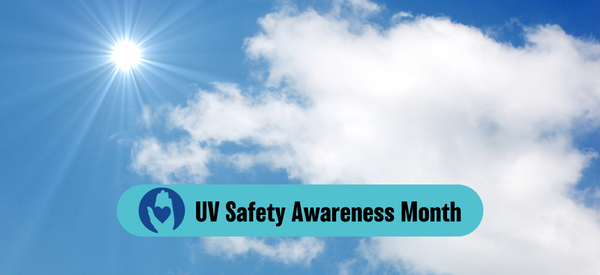Like clockwork, Summer is here and the sun is hot! While the sun is a good source of Vitamin D and mood-boosting, it is important to enjoy it safely. July is UV Safety Awareness Month to highlight the risks associated with too much sun exposure and how to protect you and your loved ones from the sun’s radiation or UV rays.
The Science Behind the Sun’s Radiation
The Sun emits UV rays known as UV-A rays and UV-B rays. UV-A rays have longer wavelengths and are associated with premature skin aging. UV-B rays have shorter wavelengths and are associated with skin burning. Both are harmful. “If you’ve had one sunburn you’ve increased your risk of skin cancer and five sunburns doubles your chances of getting skin cancer,” according to dermatologist Dr. Brodsky.
What are the Risks of Unprotected Sun Exposure?
- Skin cancer
- Suppression of the immune system
- Premature aging
- Vision problems and damage to your eyes
Warning Signs of Skin Cancer, According to Dr. Brodsky
Asymmetry – when a mole doesn’t look exactly the same on either side
Borders – if scalloped or irregular
Color – if color is not homogenous
Diameter –if diameter of lesion is larger than an eraser head
Evolving – if lesion is evolving, bleeding, itching, changing
Protect Your Skin: Doctors and Sun Screen
“Everybody should get their skin checked at least once a year,” says Dr. Brodsky. In the interim, using sunscreen properly is the number one thing to do to prevent UV damage. “Use mineral sunscreen, not chemical,” says Dr. Brodsky. This means it should have one of the following ingredients: zinc oxide, titanium dioxide, or iron oxide. Make sure the sunscreen claims to protect from UV-A and UV-B rays or describes itself as broad spectrum, which is the umbrella term for these two types of rays. Finally, make sure it’s waterproof for at least 90 minutes and reapply every two hours.
More You Could Do: Covering Up, Finding Shade, Proper Amounts of Sun Screen
Cover up using hats and sunglasses, try and stay in the shade, and make sure to use the correct amount of sunscreen. According to the National Council on Skin Cancer Prevention, most people apply only 25-50 percent of the recommended amount of sunscreen.
Ask for Help or for More Information from Health Care Providers
While thinking about the largest organ of the human body can feel overwhelming, it’s important to incorporate the simple act of putting sunscreen on into a daily routine. Whether putting sunscreen on yourself or helping out your loved ones, make sure skin health is a priority. UV-rays are active year-round and can cause damage even in the dead of winter. The sun may be 93 million miles away, but it is responsible for lighting up the entire planet. Don’t underestimate the effect it can have on your skin health! Ask your health care provider, certified caregiver, or in-home care, about protecting your skin.




